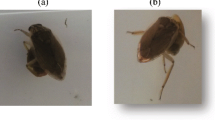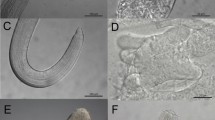Abstract
In order to determine whether the miracidia of Euparyphium albuferensis and Echinostoma friedi are sensitive to their host snail (HS) and capable of discriminating between HS and non-host snails (NHS), or whether these NHS can interfere and thus reduce the infection rates (decoy effect), a total of three experiments were conducted with HS, NHS and snail-conditioned water (SCW). Gyraulus chinensis is the HS for E. albuferensis miracidia, while Physa acuta, Radix peregra and Lymnaea fuscus are considered NHS. For E. friedi miracidia R. peregra, G. chinensis and L. fuscus are the HS, while P. acuta is the NHS. The NHS R. peregra produces the greatest decoy effect on Euparyphium albuferensis miracidia, while R. peregra, as the HS of Echinostoma friedi miracidia, is always subject to a NHS decoy effect. However, an increase in E. friedi miracidia infectivity is observed in its HS G. chinensis, in the presence of SCW of P. acuta. These experimental results might explain the low prevalence of snails infected with E. albuferensis miracidia in their natural habitat.
Similar content being viewed by others
References
Behrens AC, Nollen PM (1992) Responses of Echinostoma caproni miracidia to gravity, light, and chemicals. Int J Parasitol 22:673–675
Christensen NO (1980) A review of the influence of host- and parasite-related factors and environmental conditions on the host-finding capacity of the trematode miracidium. Acta Trop 37:303–318
Christensen NO, Nansen P, Frandsen F (1976) Molluscs interfering with the capacity of Fasciola hepatica miracidia to infect Lymnaea truncatula. Parasitology 73:161–167
Combes C, Moné H (1987) Possible mechanisms of the decoy effect in Schistosoma mansoni transmission. Int J Parasitol 17:971–975
Esteban JG, Toledo R, Sánchez L, Muñoz-Antoli C (1997) Life cycle of Euparyphium albuferensis n. sp. (Trematoda: Echinostomatidae) from rats in Spain. Syst Parasitol 38:211–219
Haas W, Haberl B (1997) Host recognition by trematode miracidia and cercariae. In: Fried B, Graczyk TK (eds) Advances in trematode biology. CRC, Boca Raton, Fla., pp 197–227
Haberl B, Haas W (1992) Miracidium of Schistosoma mansoni: a macromolecular glycoconjugate as signal for the behaviour after contact with the snail host. Comp Biochem Physiol 101A:329–333
Haberl B, Kalbe M, Fuchs H, Strobel M, Schmalfuss G, Haas W (1995) Schistosoma mansoni and S. haematobium: miracidial host-finding behaviour is stimulated by macromolecules. Int J Parasitol 25:551–560
Haberl B, Körner M, Spengler Y, Hertel J, Kalbe M, Haas W (2000) Host-finding in Echinostoma caproni: miracidia and cercariae use different signals to identify the same snail species. Parasitology 120:479–486
Kalbe M, Haberl B, Haas W (1996) Schistosoma mansoni miracidial host-finding: species specificty of an Egyptian strain. Parasitol Res 82:8–13
Kalbe M, Haberl B, Haas W, (1997) Miracidial host-finding in Fasciola hepatica and Trichobilharzia ocellata is stimulated by species-specific glycoconjugates released from the host snails. Parasitol Res 83:806–812
Kalbe M, Haberl B, Haas W (2000) Snail host finding by Fasciola hepatica and Trichobilharzia ocellata: compounds analysis of "miracidia-attracting glycoproteins". Exp Parasitol 96:231–242
Kastenholz HD, Meier-Brook C (1982) The relations between Schistosoma mansoni miracidia and a lymnaeid snail. Malacologia 22:77–80
Nollen PM (1994) The hatching behaviour of Echinostoma trivolvis miracidia and their responses to gravity, light, and chemicals. Int J Parasitol 24:637–642
Toledo R, Muñoz-Antoli C, Perez M, Esteban JG (1998) Larval trematode infections in freshwater gastropods from the Albufera Natural Park in Spain. J Helminthol 72:79–82
Toledo R, Muñoz-Antoli C, Perez M, Esteban JG (1999) Miracidial infectivity of Hypoderaeum conoideum (Trematoda: Echinostomatidae): differential susceptibility of two lymnaeid species. Parasitol Res 85:212–215
Toledo R, Muñoz-Antoli C, Esteban JG (2000) The life cycle of Echinostoma friedi n. sp. (Trematoda: Echinostomatidae) in Spain, and a discussion on the relationships within the " revolutum " group based on cercarial chaetotaxy. Syst Parasitol 45:199–217
Acknowledgements
This study was supported by the Spanish DGICYT project BOS2000–0570-C02–02, of the Ministerio de Ciencia y Tecnologia/Proyectos I+D 2000. C. M.-A. held a pre-doctoral fellowship (POST99–05–13) from the Conselleria de Cultura, Educación y Ciencia de la Generalitat Valenciana, Valencia during her work with Dr W. Haas at the Abteilung Parasitologie, Institute of Zoology of Erlangen-Nürnberg (Germany). M. T. held a pre-doctoral fellowship from the Ministerio de Educación, Cultura y Deportes, Madrid. The experiments comply with current Spanish legislation.
Author information
Authors and Affiliations
Corresponding author
Rights and permissions
About this article
Cite this article
Muñoz-Antoli, C., Trelis, M., Gozalbo, M. et al. Interactions related to non-host snails in the host-finding process of Euparyphium albuferensis and Echinostoma friedi (Trematoda: Echinostomatidae) miracidia. Parasitol Res 91, 353–356 (2003). https://doi.org/10.1007/s00436-003-0968-5
Received:
Accepted:
Published:
Issue Date:
DOI: https://doi.org/10.1007/s00436-003-0968-5




